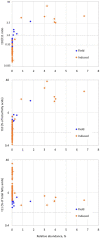Integrating data from spontaneous and induced trans-10 shift of ruminal biohydrogenation reveals discriminant bacterial community changes at the OTU level
- PMID: 36687628
- PMCID: PMC9853040
- DOI: 10.3389/fmicb.2022.1012341
Integrating data from spontaneous and induced trans-10 shift of ruminal biohydrogenation reveals discriminant bacterial community changes at the OTU level
Abstract
Introduction: Microbial digestion is of key importance for ruminants, and disturbances can affect efficiency and quality of products for human consumers. Ruminal biohydrogenation of dietary unsaturated fatty acids leads to a wide variety of specific fatty acids. Some dietary conditions can affect the pathways of this transformation, leading to trans-10 fatty acids rather than the more usual trans-11 fatty acids, this change resulting in milk fat depression in dairy cows.
Materials and methods: We combined data from an induced and spontaneous trans-10 shift of ruminal biohydrogenation, providing new insight on bacterial changes at different taxonomic levels. A trans-10 shift was induced using dietary addition of concentrate and/or unsaturated fat, and the spontaneous milk fat depression was observed in a commercial dairy herd.
Results and discussion: Most changes of microbial community related to bacteria that are not known to be involved in the biohydrogenation process, suggesting that the trans-10 shift may represent the biochemical marker of a wide change of bacterial community. At OTU level, sparse discriminant analysis revealed strong associations between this change of biohydrogenation pathway and some taxa, especially three taxa belonging to [Eubacterium] coprostanoligenes group, Muribaculaceae and Lachnospiraceae NK3A20 group, that could both be microbial markers of this disturbance and candidates for studies relative to their ability to produce trans-10 fatty acids.
Keywords: biohydrogenation; dairy cow; milk fat depression; ruminal bacteria; trans-10 fatty acids.
Copyright © 2023 Enjalbert, Zened, Cauquil and Meynadier.
Conflict of interest statement
The authors declare that the research was conducted in the absence of any commercial or financial relationships that could be construed as a potential conflict of interest.
Figures






Similar articles
-
A canonical discriminant analysis to study the association between milk fatty acids of ruminal origin and milk fat depression in dairy cows.J Dairy Sci. 2018 Jul;101(7):6497-6510. doi: 10.3168/jds.2017-13941. Epub 2018 Apr 5. J Dairy Sci. 2018. PMID: 29627248
-
Diet-induced milk fat depression is associated with alterations in ruminal biohydrogenation pathways and formation of novel fatty acid intermediates in lactating cows.Br J Nutr. 2017 Feb;117(3):364-376. doi: 10.1017/S0007114517000010. Epub 2017 Feb 27. Br J Nutr. 2017. PMID: 28236814
-
Alterations in ruminal bacterial populations at induction and recovery from diet-induced milk fat depression in dairy cows.J Dairy Sci. 2018 Jan;101(1):295-309. doi: 10.3168/jds.2016-12514. Epub 2017 Nov 2. J Dairy Sci. 2018. PMID: 29103706 Clinical Trial.
-
Invited review: Role of rumen biohydrogenation intermediates and rumen microbes in diet-induced milk fat depression: An update.J Dairy Sci. 2020 Sep;103(9):7655-7681. doi: 10.3168/jds.2019-17662. Epub 2020 Jun 27. J Dairy Sci. 2020. PMID: 32600765 Review.
-
A decade of developments in the area of fat supplementation research with beef cattle and sheep.J Anim Sci. 2008 Apr;86(14 Suppl):E188-204. doi: 10.2527/jas.2007-0546. Epub 2007 Dec 21. J Anim Sci. 2008. PMID: 18156350 Review.
Cited by
-
Anaerobic flora, Selenomonas ruminis sp. nov., and the bacteriocinogenic Ligilactobacillus salivarius strain MP3 from crossbred-lactating goats.Sci Rep. 2024 Feb 28;14(1):4838. doi: 10.1038/s41598-024-54686-6. Sci Rep. 2024. PMID: 38418870 Free PMC article.
-
Longitudinal Distribution Map of the Active Components and Endophytic Fungi in Angelica sinensis (Oliv.) Diels Root and Their Potential Correlations.Metabolites. 2024 Jan 12;14(1):48. doi: 10.3390/metabo14010048. Metabolites. 2024. PMID: 38248851 Free PMC article.
References
-
- Arbonés-Mainar J. M., Navarro M. A., Guzmáan M. A., Arnal C., Surra J. C., Acín S., et al. (2006). Selective effect of conjugated linoleic acid isomers on atherosclerotic lesion development in apolipoprotein E knockout mice. Atherosclerosis 189, 318–327. doi: 10.1016/j.atherosclerosis.2006.01.015, PMID: - DOI - PubMed
-
- Bach A., López-García A., González-Recio O., Elcoso G., Fàbregas F., Chaucheyras-Durand F., et al. (2018). Changes in the rumen and colon microbiota and effects of live yeast dietary supplementation during the transition from the dry period to lactation of dairy cows. J. Dairy Sci. 102, 6180–6198. doi: 10.3168/jds.2018-16105, PMID: - DOI - PubMed
-
- Baumgard L. H., Matitashvili E., Corl B. A., Dwyer D. A., Bauman D. E. (2002). Trans-10, cis-12 conjugated linoleic acid decreases lipogenic rates and expression of genes involved in milk lipid synthesis in dairy cows. J. Dairy Sci. 85, 2155–2163. doi: 10.3168/jds.S0022-0302(02)74294-X, PMID: - DOI - PubMed
LinkOut - more resources
Full Text Sources

